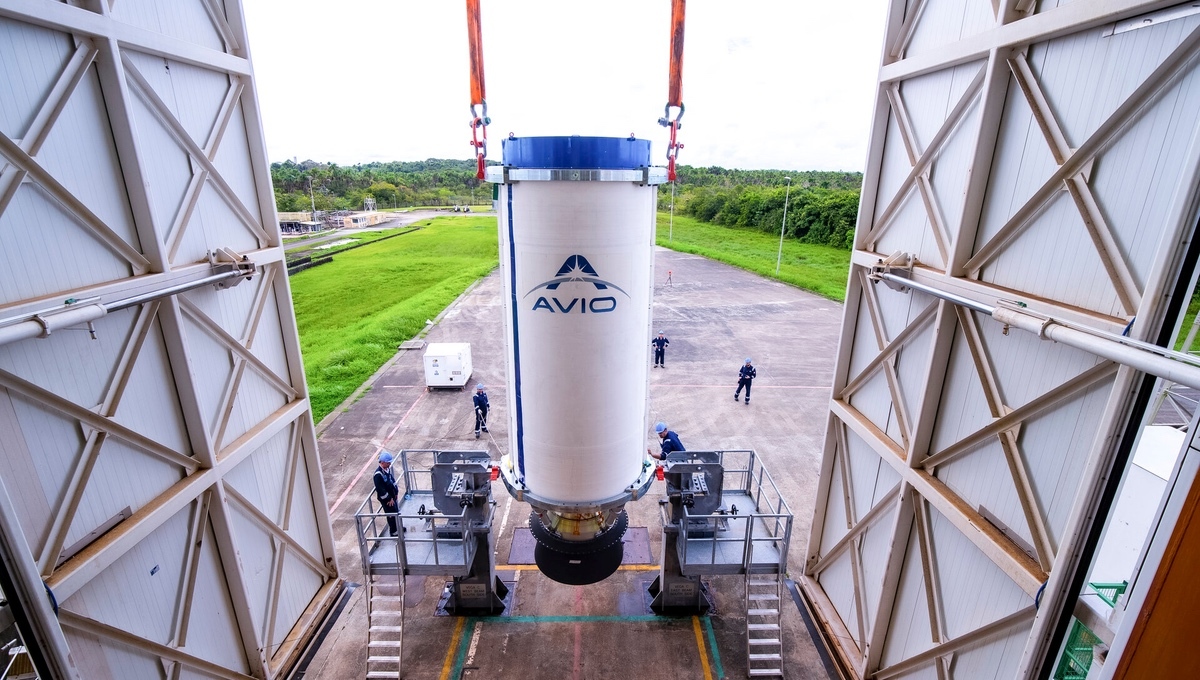3.10.2023

A Zefiro 40 motor. A static-fire test of the motor suffered an anomaly June 28. Credit: ESA/M. Pedoussaut
WASHINGTON — The return to flight of Europe’s Vega C small launch vehicle has slipped to late 2024 after the European Space Agency concluded a rocket motor nozzle needs to be redesigned.
ESA announced Oct. 2 the completion of an independent investigation into an anomaly that took place during a static-fire test of a Zefiro 40 motor June 28. That test was part of efforts to return the Vega C to flight after a December 2022 launch failure blamed on that motor.
Giovanni Colangelo, ESA’s inspector general and chair of the committee that investigated the incident, said at a briefing that the performance of the motor was “more or less normal” until 39.7 seconds after ignition. At that point, a new throat insert made of carbon-carbon material was expelled from the nozzle, along with other pieces of the nozzle. The motor continued to burn, although at far lower pressures, until the fuel was exhausted.
The test was intended to confirm the performance of the throat insert, which prime contractor Avio had replaced as part of the recommendations into the December 2022 launch failure. That investigation, released in March, concluded that carbon-carbon material from the original supplier, Ukrainian company Yuzhnoye, did not meet specifications. ArianeGroup now supplies the throat insert. At the time ESA hoped to resume Vega C flights by the end of 2023.
The June test anomaly was not linked to that launch failure, ESA concluded. “The failure of the test is related to the design of the nozzle that was not upgraded with the change in the carbon-carbon supplier for the throat insert,” Colangelo said. The geometry of the new throat insert and its different thermo-mechanical properties contributed to the failure. “The effects had not been identified as critical during the redesign.”
He said that as early as one second into the test, debonding of the throat insert from the metallic nozzle had started, which grew progressively worse. Eventually, hot gas from the exhaust got into gaps in the nozzle, causing the ejection of the throat insert and other nozzle components.
ESA recommended that the Zefiro 40 nozzle be redesigned, along with improved modeling of its performance and two static-fire tests of that new design. A joint task force of Avio and ESA personnel has already started that work, said Giulio Ranzo, chief executive of Avio. “We have to conduct, I would say, an adjustment of the design, a modification of the design of part of the nozzle.”
That redesign will lead to one static-fire test in the second quarter of 2024, he said, which will be used to both confirm the performance of the redesigned nozzle as well as refined numerical models. That will be followed by a second static-fire test before Vega C is ready to return to flight.
That return to flight of Vega C is now planned for the fourth quarter of 2024. “We plan to test on the ground as much as we can prior to flight to secure that we have done a good job in adapting the design,” said Ranzo.
Before the Vega C return to flight will be two launches of the original version of the Vega, which does not use the Zefiro 40 motor. The first is scheduled for Oct. 6, and will place into orbit the THEOS-2 Earth observation satellite for Thailand, the FORMOSAR-7R/TRITON radio occultation satellite for Taiwan and 10 smallsat second payloads.
The second, and final, Vega launch is scheduled for the second quarter of 2024. Stéphane Israël, chief executive of Arianespace, said the payload for that mission, along with the Vega C return to flight, have yet to be identified. Arianespace expects to perform four Vega C flights in 2025 and subsequent years, with the possibility of increasing that launch rate to five or six a year.
The Vega C manifest includes several launches for Copernicus, the joint Earth observation program of ESA and the European Commission. Among them is Sentinel-1C, a radar imaging satellite considered so critical that, at one point, ESA has discussed moving up its launch from the first half of 2023 before the Vega C launch failure took place last December. The spacecraft is too large to launch on the original Vega.
“We are discussing with the European Commission and also with ESA how to best accommodate this situation,” Israël said. That includes, he said, finding “the best solutions to speed up what we can speed up.”
ESA Director General Josef Aschbacher said any decision to move Sentinel-1C to a different launch vehicle, including a non-European one, will be in the hands of the European Commission, which takes ownership of the satellite before launch. “They will decide where and when to launch this satellite,” he said.
Israël said that Arianespace was working with other Vega C customers to discuss the implications of this latest delay. “We do not expect that many will leave,” he said.
ESA said that the cost of the additional work to return the Vega C to flight will be funded within existing budgets. Toni Tolker-Nielsen, ESA’s director of space transportation, said the full return-to-flight costs were about 25–30 million euros ($26.3–31.6 million.)
Quelle: SN
